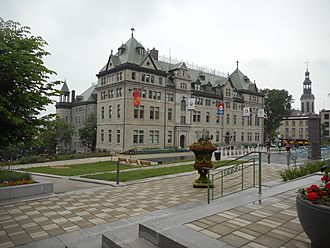City Hall of Quebec City facts for kids
Quick facts for kids Quebec City Hall |
|
|---|---|
|
Hôtel de ville de Québec
|
|

Quebec City Hall
|
|
| General information | |
| Address | 2, rue des Jardins Quebec City, Quebec G1R 4S9 |
| Coordinates | 46°48′50″N 71°12′29″W / 46.81391°N 71.207954°W |
| Inaugurated | 1896 |
| Design and construction | |
| Architect | Georges-Émile Tanguay |
| Official name: Québec City Hall National Historic Site of Canada | |
| Designated: | 1984 |
| Reference #: | 695 |
The City Hall of Quebec City (in French, Hôtel de ville de Québec) is the main building for the local government in Quebec City, Quebec, Canada. It is where the city's leaders meet and make important decisions. This historic building officially opened on September 15, 1896. It is located in the beautiful Old Quebec area.
Contents
Quebec City Hall: A Historic Landmark
The City Hall is built on a hill, so it slopes downwards. Before it became the City Hall, the land was home to the Jesuit College. This college was there from the 1730s until 1878.
A Building with a Rich Past
The City Hall of Quebec City is very important. In 1984, it was named a National Historic Site of Canada. This means it is recognized for its special history and importance to the country.
The building is also part of the "Arrondissement historique du Vieux-Québec." This is a historic district that was recognized by the province in 1963. In 1985, this entire district became a World Heritage Site. This means it is considered important to the whole world!
Design and Architecture
The City Hall is located on rue des Jardins. It was designed by a famous architect named Georges-Émile Tanguay. He lived from 1858 to 1923. This building was the second permanent city hall for Old Quebec.
Before this building, the city government met in different places. From 1842 to 1896, the City Hall was in the home of a British Army officer named William Dunn (British officer). The formal Quebec City Council was first created in 1833.
The building's design mixes different styles. It includes parts of Classical, Medieval, and Châteauesque styles. This mix makes it look unique and grand.
See also
 In Spanish: Ayuntamiento de Quebec para niños
In Spanish: Ayuntamiento de Quebec para niños

